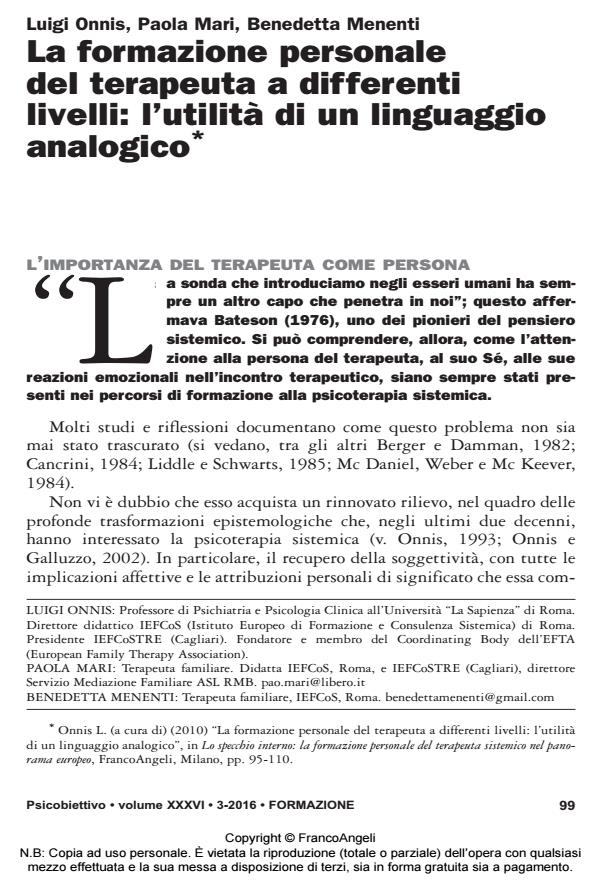Training of therapists on different levels: the usefulness of an analogic language
Journal title PSICOBIETTIVO
Author/s Luigi Onnis, Paola Mari, Benedetta Menenti
Publishing Year 2016 Issue 2016/3
Language Italian Pages 14 P. 99-112 File size 108 KB
DOI 10.3280/PSOB2016-003006
DOI is like a bar code for intellectual property: to have more infomation
click here
Below, you can see the article first page
If you want to buy this article in PDF format, you can do it, following the instructions to buy download credits

FrancoAngeli is member of Publishers International Linking Association, Inc (PILA), a not-for-profit association which run the CrossRef service enabling links to and from online scholarly content.
In this article, the authors describe a working model on the systemic therapist, adopted in the training program of the Italian Institutes IEFCoSTRE. They underline that the training of the therapist does not need particular spaces separate from those of the training, as these might become too specific therapeutic spaces (except in those cases in which the student clearly requires a subjective therapy); on the contrary, the authors believe that the work on the therapist has to take place within the educational process, through the different stages of its development. The authors identify four levels: a) the work on the student’s family history; b) the analysis of interpersonal dynamics in the training group; c) the work on the student through direct supervision, which allows to analyse the impact of emotional reactions with family during therapy; d) the work on the student through indirect supervision, which allows to evaluate the student’s ability to govern their own inner world, one’s "Self" in therapy. The authors focus the discussion, in particular, on the first of these levels, the work on the student’s family history, which starts with the genogram and continues with other analog and metaphorical constructions (sculptures, fairytales, metaphorical narratives). They accentuate the usefulness of working with an analog and metaphorical language which results to be particularly effective in allowing to emerge what, usually, cannot be expressed with words: "nodes" unresolved and unconscious of the student’s inner world, which cannot be immediately explored through rational thought. It is presented, by way of example, the work on the family history of a student. More generally, the authors point out that the entire training process can be interpreted in terms of student life cycle oriented to acquire a progressive autonomy and individuation of "being a therapist".
Keywords: Personal Development of the Therapist; Systemic Training; Family History; Metaphorical Language.
- Un filo continuo nello spaziotempo della formazione relazionale Ilaria Genovesi, Simona Vatteroni, Francesca Deri, Emanuela Laquidara, in RIVISTA DI PSICOTERAPIA RELAZIONALE 59/2024 pp.45
DOI: 10.3280/PR2024-059003
Luigi Onnis, Paola Mari, Benedetta Menenti, La formazione personale del terapeuta a differenti livelli: l’utilità di un linguaggio analogico in "PSICOBIETTIVO" 3/2016, pp 99-112, DOI: 10.3280/PSOB2016-003006